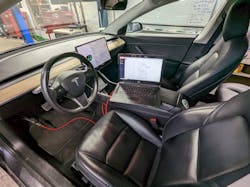ACDC has been in the Electric and Plug-in Hybrid technician training business literally since the first affordable (under $45K) plug-ins hit the market in 2010, the Chevy Volt and Nissan Leaf. Tesla came out with their electric roadster a couple years before, at a price of $100,000. With our shiny new Chevy Volt, plugging in a car was now a thing. Nissan Leaf was the next ACDC purchase at about the time the Tesla Model S was sold. When the Model X came out, my company leased a Chevy Bolt, then bought a Kia Niro EV about the time the Model 3 was launched. Why did ACDC stay away from Tesla all that time? No factory scan tool. Was I personally interested in them? Somewhat, but a chance meeting changed my views.
Let me introduce Aiden Neary. Aiden works at ACDC. I met him at an electric car show when he was 17 years old. His father, Robert Neary, showed up in a dirty 2013 Tesla Model S with wires hanging out of the dash, so I stuck around until the owner showed up with Aiden in tow. Aiden, a self-proclaimed “geek”, grew up in his father’s EV. The two of them took a class we offered on high voltage battery technology and Aiden impressed me with his knowledge. Robert and I talked about hiring Aiden part time when he was a senior in high school. Aiden was a natural. College is in Aiden’s future, but for now he is having fun, traveling and holding court all over the USA at ACDC Tesla classes. At the young age of 22, Teslas are in his blood. My thanks to Aiden for his help in writing this article.
In late 2021 Tesla released “Toolbox,” a Tesla vehicle scan tool of sorts. This was the first public sign that Tesla had overplayed its hand and needed the aftermarket shops to bail them out. The writing was on the wall for quite some time that selling almost a million cars in 2021 and not expanding their service centers would end up with many unhappy Tesla owners. This also had a negative effect on the employees who worked at the Tesla repair shops. ACDC coined the word “EMV” when hybrid cars added plugs and EVs come into the marketplace, around 2010. At that time Tesla had an electric roadster and the Model S was under development. EMV is used to describe any high voltage vehicle, be it hybrid (HEV), plug-in hybrid (PHEV), electric vehicle (BEV or EV), EV with range extender (EV-RE), fuel cell vehicle (FCEV) or a plug-in fuel cell vehicle (FCPEV).
It had always been possible for ACDC to stay up to date with EMV technology so we could offer classes and tech support, until Tesla became a car company. In 2000 ACDC took delivery of a Honda Insight, the first hybrid sold in America. Scan tool, service manuals (yes, books) and tools were available on day one. The National Automotive Service Task Force (NASTF) was created in 2000 and I was fortunate to be at the first meeting in Las Vegas. In the beginning, we met twice a year, Detroit in the spring and Las Vegas in the fall. Tesla was not a company yet. The focus of NASTF was to ensure that vehicle owners had a choice on where to get their car or truck fixed. In states like Massachusetts (where I live and work) vehicles are tested for safety and emissions, therefore aftermarket shops here must keep up with equipment, service information and training to compete with dealerships. Keep in mind that most of NASTF’s work was emissions related. In 2011 when Tesla came out with their 2012 Model S, it had no tail pipe emissions, so Tesla took a pass on joining NASTF. All other OEMs at that time willingly (or unwillingly) signed a letter of understanding to cooperate with the aftermarket repair industry to avoid legislation. As a result, the OEMs provided factory scan tools, special tools, parts and service information for the aftermarket for a fee. While all this was going on, Tesla was selling more and more EVs.
So much for history. Let us get into what we know now.
Tesla preventive maintenance
Tesla is a bit ambiguous (see figure 1) about what they tell their customers in regard to check-ups
On the same website you will also see suggestions for preventive maintenance (PM).
As you can see, Tesla recommends preventive maintenance when a Tesla service center is nearby, but also tells owners that annual preventive maintenance is unnecessary, unless it is tires or brake service.
ACDC has a generic EV preventive maintenance schedule added to our new EV book. This may be a better approach to suggest preventive maintenance to a new Tesla customer that seeks you out.
Why did Tesla design a scan tool into their car?
Today, if you live in Sidney, N.D., and need service, the closest Tesla service center is more than 600 miles away in Minnesota. Tesla pioneered over-the-air software updates for that reason, as the owner can initiate a software download with a text message to Tesla on their smart phone app. Remember, this was over 12 years ago. If Tesla could convince buyers that their cars needed no preventive maintenance and never broke down, then being 600 miles away from a shop is not a problem, right? Years ago, Tesla had very few service centers and today waiting for service and repairs is common.
The Tesla scan tool
There are three scan tool terms used by Tesla that you need to understand.
- “Service Mode” Is a limited, built-in scan tool accessed without a subscription. It is free and we will call it “SMF,” or Service Mode Free.
- “Service Mode +” is a more in-depth scan tool. It’s also built into the vehicle, but it must be “unlocked” with a subscription to “Toolbox 3”. We will call it “SMP,” or Service Mode Plus.
- “Toolbox 3” Is a laptop-based scanner that is used when in SMP to do most programming and active tests. We will refer to this as “Toolbox.”
How Tesla designed their scan tool to function
To keep things simple, I’ll define the “Factory Scan Tool” as the combination of SMP and Toolbox (web application not a download). Toolbox works by using a five-pin connector on the car to an ethernet cable (ETH) on your laptop, and it enables you to communicate and send commands to the vehicle for servicing. An example would be retracting the rear parking brakes so that you can install a new set of pads when servicing the rear brakes. SMP is just a software feature in the vehicle that is accessed by paying for Toolbox.
Since Tesla uses a diagnostic connector to access information being reported in the vehicle, the car can talk with your laptop in the same language and be given a “Key” to unlock SMP on the center screen. The “Key” being used here is a series of lines of code sent from your laptop to your car that you paid Tesla for in the form of the Toolbox web application.
Because Tesla did not design and build a traditional hand-held scan tool or a laptop-based scanner, Toolbox and the center screen acts as the scan tool. The information about the vehicle’s onboard systems and their status is displayed on the center screen. Tesla does not use a 16-pin OBD port.
SMP is a mode that is commanded by Toolbox (your laptop), for servicing the vehicle. Many service procedures and some reprograming can be done without Toolbox for free using the built-in factory software (SMF). Toolbox is available to purchase from Tesla to anyone who is willing to pay for it. It is needed for most reprogramming and active testing.
Using the in-dash software
The center screen ends up becoming your handheld scanner equivalent. Once you put the car into SMP by logging into your Toolbox account, plugging your laptop into the vehicle’s diagnostic port, and commanding it into SMP, you can view live data, perform basic procedures such as a software reinstall, brake burnishing mode, HV Battery discharge function, and many more. Once in SMP, the customer no longer has control of their Tesla with their phone. You can only put the car into SMP if you have an active subscription for Toolbox.
Accessing SMF
Most simple service procedures can be done with the car being in “SMF,” which is accessed through the vehicle’s screen by going to the software menu, holding your finger on the car’s Make and Model button, and then typing in “service” when prompted. Toolbox and SMP only come into the picture for heavy diagnostics or repair. You will get better live data lists, more menus, more buttons, control module reprograming, active tests and functions for every electronically controlled component in the vehicle. Like all scan tools, there is a learning curve.
How much does it cost to use a Tesla scan tool?
The factory scanner is $3,000 per year — or $500 per month or $165 per day. Most service tools are under $2,500 for 90% of what you need. This assumes you are a full-service repair shop. Many Euro shops are calling us as they are losing their customers to Tesla, so we stock a “Tesla service kit” that helps you get into Tesla service.
Tips for Service Advisors
- Most owners use their cell phone as a key, so remind them to bring their “key fob” with them.
- The owners have access to all their previous service work done by Tesla. Ask them to email the Tesla repair reports to you when they make their first appointment.
- Tell the customer that their Tesla app will have a limited view and will restrict communication once you put the car in “Service Mode.”
- When making an appointment, schedule enough time for parts and analytical work.
- If a reflash is required, make sure the customer knows a minimum fee of at least a one-day Tesla subscription will be charged. Some preventive maintenance, like a brake fluid flush, will require a factory scan tool.
Buying a Used Tesla
ACDC bought a used Tesla Model 3 Dual Motor extended range at the peak of their value (June 2012) and Aiden Neary was elevated to the position of ACDC Tesla instructor. He handled the registration with Tesla once we took delivery. The previous owner did not let Tesla know it was sold, so right away we had a problem. Aiden contacted Tesla in California and they in turn contacted the previous owner and verified that they sold their car. Once that was done, we were able to access the Tesla app on our phones, add a credit card so we could use the Tesla Super Charger network and use our cell phones as keys. If you get into the Tesla service business (which I highly recommend), there are more challenges than just repair and service. You have to take care of the customers too.
Used Tesla EV prices have dropped considerably this year. $20,000 will get your shop a Tesla. Add your name or wrap the car, make a website and get to work. This opportunity will only last for a while.
In the meantime, look for more Tesla articles in the future.
About the Author

Craig Van Batenburg
Craig Van Batenburg is the CEO of ACDC, a hybrid and plug-in training company based in Worcester, Mass. ACDC has been offering high voltage classes since 2000, when the Honda Insight came to the USA. When EVs were introduced in 2011, ACDC added them to their classes. Reach Craig via email at [email protected] or call him at (508) 826-4546. Find ACDC at www.FIXHYBRID.com.
